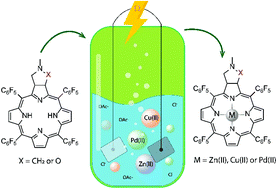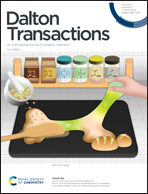Ohmic heating-assisted synthesis and characterization of Zn(ii), Cu(ii) and Pd(ii) complexes of heterocyclic-fused chlorins†
Abstract
Chlorins are highly interesting compounds due to their spectroscopic properties in both UV-Vis and NIR regions. Upon coordination to a metal ion, the corresponding metallochlorins exhibit more valuable physicochemical properties that enable a broader range of applications, such as in photodynamic therapy (PDT), water splitting catalysis, optical sensor devices and dye-sensitized solar cells. Synthetic chemistry has been in a continuous quest to fulfil most green chemistry requirements through the development of efficient reactions. Being a heating process that does not depend on heat transfer to the reaction medium, ohmic heating accomplishes the mentioned requirements and allows a fast and uniform heating regime thanks to the ionic conductivity of the reaction medium. Herein, we report the metallation of pyrrolidine- and isoxazolidine-fused chlorins with Zn(II), Cu(II) and Pd(II) salts by ohmic heating, using non-toxic aqueous solutions, and their corresponding physico-chemical characterization. All pyrrolidine-fused chlorins showed higher yields, when compared with isoxazolidine ones. From the thermogravimetric analysis performed it is possible to infer that the metal enhances the steadiness of the macrocycle, making it easier to cause the thermal decomposition of the pyrrolidine- and isoxazolidine-fused chlorins. The Zn(II) complexes showed high absorption in the NIR spectral region, a low fluorescence quantum yield and a short excited singlet state, which indicate the high efficiency of intersystem crossing to the triplet state, making them very promising candidates as photosensitizers for PDT.



 Please wait while we load your content...
Please wait while we load your content...